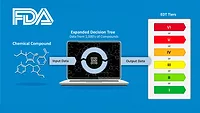FDA Seeks Input on New Method for Ranking Chemicals in Food for Post-Market Assessments

Image credit: jannoon028 via Freepik
The U.S. Food and Drug Administration (FDA) has released for public comment its proposed method for ranking chemicals in the food supply that will be prioritized in post-market safety assessments.
“This method provides a transparent, systematic, and science-based approach to determine which chemicals the agency would prioritize for post-market assessments through the agency’s post-market chemical review program,” FDA said in a statement. “It will allow the FDA to allocate resources more efficiently, ensuring that the agency focuses on food chemicals that may present the greatest potential public health risk, including risk to sensitive populations, and are of high public concern.”
Determining if a chemical—either one intentionally added to food or a contaminant that is not intentionally added—needs to be further evaluated based on new information takes a structured and science-based approach to ensure that FDA’s reviews are most protective of the health of consumers, FDA said.
The method released on June 18 uses Multi-Criteria Decision Analysis (MCDA) to determine a score for each chemical based on evaluating the information about a chemical against a pre-determined set of criteria.
“The method is similar in approach and criteria to one that the U.S. Environmental Protection Agency uses for prioritizing chemicals, but the FDA’s method takes into account factors specific to exposure from food and uses a scoring method similar to the FDA’s Risk Ranking Model for Traceability,” FDA said.
FDA says stakeholder input is “critical” to inform its method and overall approach to post-market assessments of chemicals in the food supply.
FDA encourages the public to comment in docket FDA-2025-N-1733 in response to the questions listed in Section 4 of the method description document.
Looking for quick answers on food safety topics?
Try Ask FSM, our new smart AI search tool.
Ask FSM →
The last day to submit comments on the method is July 18, 2025. After the public comment period closes, FDA will submit the method and public comments for further evaluation by external scientific experts in line with the requirements of the Information Quality Act.
Update, July 15, 2025: FDA has extended the public comment period by 30 days.









